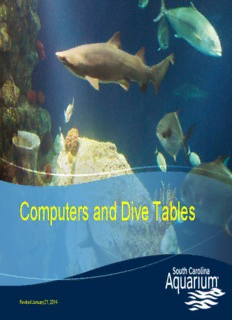
Computers and Dive Tables - South Carolina Aquarium PDF
Preview Computers and Dive Tables - South Carolina Aquarium
Computers and Dive Tables Revised January 21, 2014 Arnold Postell Senior Biologist / Dive Safety Officer • Work: 579-8536 • Email: [email protected] • Please address any questions regarding training or use directly to the DSO. It is the mission of the South Carolina Aquarium (SCA) Dive Team to provide excellence in animal care and husbandry, to actively support both the educational and conservation endeavors of the SCA, and to provide a memorable, positive guest experience to all those who visit our facility . Training Schedule • PowerPoint Presentation > Statement of Understanding and Quiz required before in-water use • GOT: 2 supervised dives Training • Dive computer training will include: Personal instruction and diver access to all literature supplied by the computer manufacturer, including display interpretation, proper operation and basic maintenance.! Training Cont. • A written examination covering basic decompression theory, specifics on the computer to be used, computer diving safety and SCA guidelines for computer diving.! Effects of Compressed Gas on Divers • Divers using compressed gas intake abnormal partial pressure of nitrogen or possibly oxygen in the case of enriched air (nitrox) use. • Increased levels of nitrogen can lead to possible DCS issues and increased levels of oxygen can lead to oxygen toxicity Planning a Dive • Due to the issues of breathing compressed gasses mentioned in the previous slide, divers need to plan their dives to minimize risk • Dive Tables are the original method for planning a dive • Dive computers have evolved based off of dive tables and can give an instantaneous tracking of possible gas loads J.S Haldane Father of Decompression Theory” • “ • Physiologist appointed to develop decompression tables for the Royal Navy divers. • Tables were based off of tissue saturation theory and experimentation on goats. U.S Navy Tables • Based on Haldanes tissue compartment work. 1907 • 1930’s U.S navy researchers used human volunteers. It took until 1957 to publish the original Navy tables. • 564 dives resulting in 26 case of decompression sickness • 122 repetitive dives based on 61 profiles with 3 cases of bends. • “M” values of supersaturation ratios for each compartment • 5,10,20,40,80 and 120 minute tissues. • Tables are based on actual dives using tissue compartment theory.
Description: